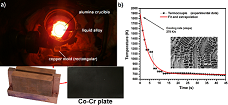
Ana RamÃrez Ledesma
Instituto de Investigaciones en Materiales, Mexico
Title: Fabrication of Co-Cr alloys for biomedical applications by implementing rapid solidification
Biography
Biography: Ana RamÃrez Ledesma
Abstract
Statement of the Problem: It is well known that actually there is a lack of innovation with respect solidification processes on Co-Cr based alloys for biomedical applications (e. g. dental implants and permanent stents). Moreover, the most conventional technique to obtain Co-Cr biomedical devices is the investment casting process. Which involves inherent microstructural defects as a high percentage of interdendritic segregation and several precipitates distributed along the microstructure. All these features results in a decrement of the mechanical properties in Co-Cr alloys used in the biomedical field. Methodology & Theoretical Orientation: High purity cobalt (99.99 %) and chromium (99.99 %) were used as starting metals for processing the experimental Co-Cr alloy. Rapid solidification regime was confirm trough the temperature profile recorded using an Amprobe TMD90A Digital Thermometer with R type thermocouples inserted into a ceramic sheath, embedded in the cooling metal. Findings: Rapid solidification promotes the elimination of interdendritic segregation and, in consequence, a diminution of precipitates can be achieved. On the other hand, a control in the γ-Co, FCC ↔ ε-Co, HCP transformation were reached. The above microstructural and crystallographic features are related with the improvement on the mechanical properties and corrosion resistance on Co-Cr alloys. Theoretical solidification models were used to understand several features of rapid solidification regime imposed on Co-Cr alloys. These consist in a competitive growth analysis to predict the growth temperature limits of the eutectic constituent and the solid solution for the alloy system. Conclusion & Significance: Nowadays, Co-Cr alloys still are very important in the biomedical field. For this reason, it is important and necessary to propose alternative and innovative solidification procedures to fabricate Co-Cr biomedical devices. Consequently, we can improve their mechanical and corrosion properties significantly through a microstructural control.


